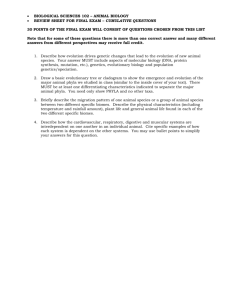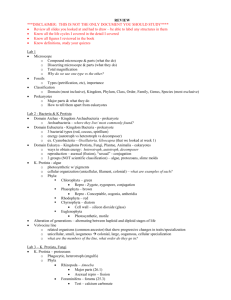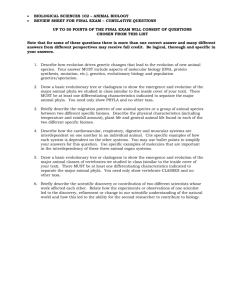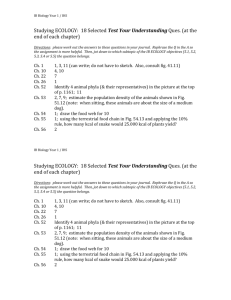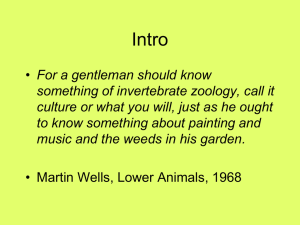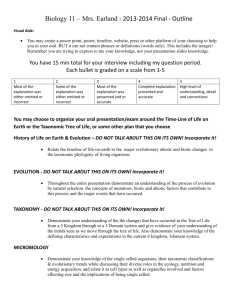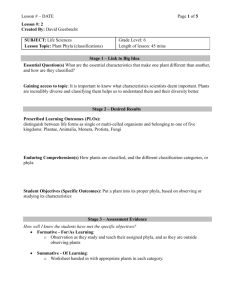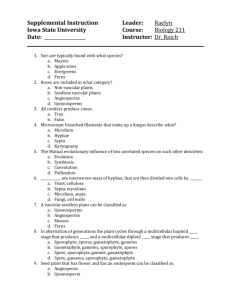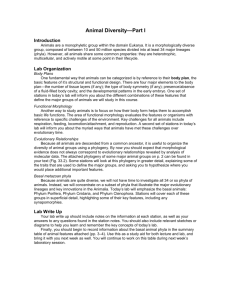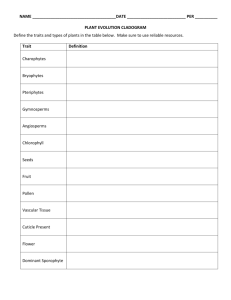Plant diversity and evolution for life on land
advertisement
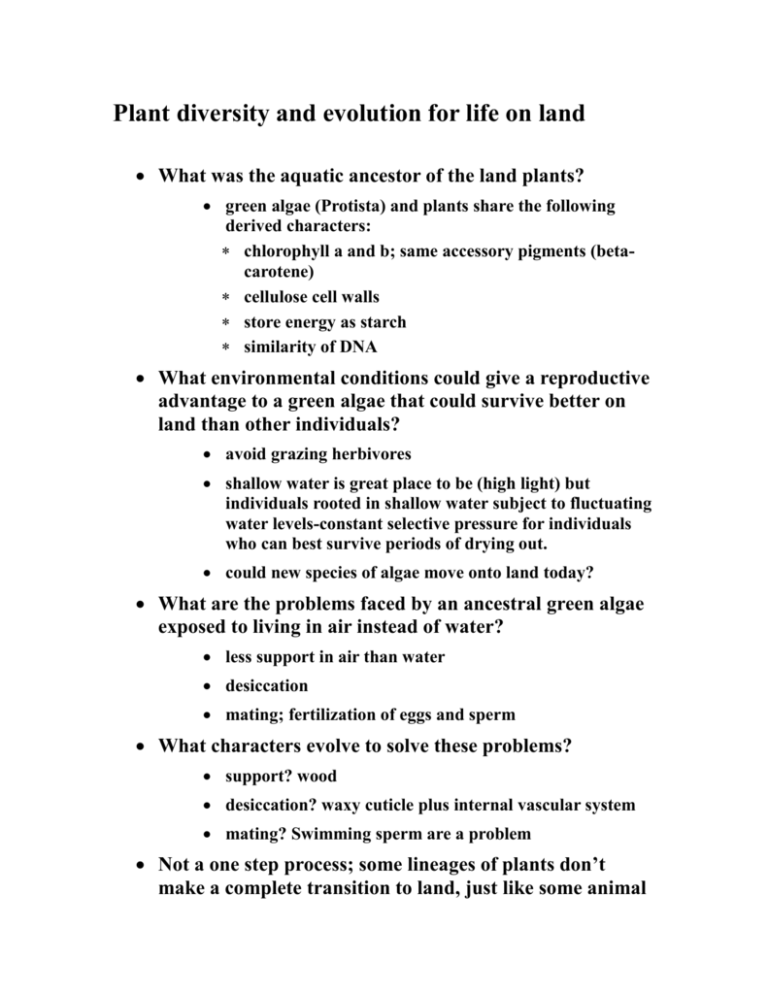
Plant diversity and evolution for life on land What was the aquatic ancestor of the land plants? green algae (Protista) and plants share the following derived characters: chlorophyll a and b; same accessory pigments (betacarotene) cellulose cell walls store energy as starch similarity of DNA What environmental conditions could give a reproductive advantage to a green algae that could survive better on land than other individuals? avoid grazing herbivores shallow water is great place to be (high light) but individuals rooted in shallow water subject to fluctuating water levels-constant selective pressure for individuals who can best survive periods of drying out. could new species of algae move onto land today? What are the problems faced by an ancestral green algae exposed to living in air instead of water? less support in air than water desiccation mating; fertilization of eggs and sperm What characters evolve to solve these problems? support? wood desiccation? waxy cuticle plus internal vascular system mating? Swimming sperm are a problem Not a one step process; some lineages of plants don’t make a complete transition to land, just like some animal groups are ‘amphibian’. What are the major taxa of plants? Fig 29.1 Phylogeny of Plants Primitive terrestrial plant phyla (Phylum) are small and restricted to wet sites for reproduction. Bryophyta (including liverworts and hornworts) Moss. support? Lack vascular system which provides support in other plants, thus they stay small- desiccation? Incomplete cuticle and are tolerant to drying out sex? females retain gametes male gametes swim to fertilize egg--need free water for reproduction diploid sporophyte receives nutrients from gametophyte survive in places that stay wet for some extended part of year—dry out at other times Vascular tissues and more complete cuticle results in adaptive radiation on land of seedless vascular plants. 3 Phyla: ferns (Pterophyta), horsetails (sphenophyta) and lycopods (lycophyta) support? vascular tissues provide support and circulation to large body = xylem + phloem desiccation? complete cuticle reproduction? Differs from moss; sporophyte is dominant (2n). Similar to moss; gametophyte is free-living, eggs retained, sperm swim, zygote develops into an embryo that is nourished by gametophyte. Seeds are an evolutionary novelty that results in another adaptive radiation. What could seed producing plants do that their ancestors could not? seed What could seed producing plants do that their ancestors could not? resource acquired during life of sporophyte cannot be passed onto its offspring in seedless plants. each generation begins from spores carrying nothing but genetic information—all energy for growth of the spore into a gametophyte must come thru photosynthesis in contrast, a sporophyte of a seed plant fills a seeds with energy reserves (fat, starch, or protein) and its embryo (sporophyte) seeds allow colonization of drier habitats for two reasons: energy in seed allows rapid early growth and establishment-provides energy to build photosynthetic machinery (like getting a loan to build a business) swimming sperm eliminated, because now sporophyte must retain female spores, male spores released as pollen. Male gametophyte contained within pollen grain—after pollen carried to female, it produces sperm. What plants produce seeds? Gymnosperms and Angiosperms produce seeds first appear in fossil record about 300mya during Carboniferous period (dominant plants were seedless vascular plants living in large swamps) During age of dino’s, 245-65 mya, gymnosperms dominate 4 extant phyla of gymnos, but we will look at only two: Coniferophyta (Conifers)—pines, cedars, redwoods, spruce Cycadophyta (cycads)- Flowers are an evolutionary novelty that results in another adaptive radiation. Only angiosperms produce flowers = flowering plants; evolved from gymnosperm ancestors first fossil angiosperms appear about 150 mya and they are small, herbaceous things—fossil story is less complete than during swampy periods when seedless plants dominated; why? seeds allowed colonization of drier habitats... What could flowering plants do that their non-flowering seed plant anscestors could not? flowering plants are insect pollinated—some secondarily wind pollination, but it appears to be convergent evolution due to similar environmental conditions what’s advantage of insect pollination? for wind pollination it helps to be tall and have plants around you be the same species woody gymnosperms were major diet of sauropod dinos then transition to ceritopcians and low grazers. What were they grazing on? both small gymnosperms and angiosperms. gymnosperms are not well adapted for grazing, but herbaceous angiosperms are for several reasons: grazing tolerant grow and reproduce in short time, perhaps escaping from herbivores by luck. insect pollination allows for a population of scattered, low growing individuals Diversity of animals Diverse…1 million named species, and many more unnamed species 35 phyla most of which are invertebrates most phyla are aquatic, only 2 phyla are completely terrestrial Phylogeny of animals probably monophyletic with a colonial protist as ancestor Cambrian Explosion: all 35 phyla appear over 5-10 million year period 545 mya ( beginning of Cambrian) Fossils are rare, but occur under some conditions: Burgess Shale is cambrian-contains all 35 phyla and perhaps more Evolutionary novelties probably fuel the cambrian explosion, but its not clear what they are (HOX genes) environmental changes could also be important; i.e., rising oxygen content of atmosphere could allow for more active animals such as predators. phylogeny based on comparative anatomy (analogy and homology) and embryonic development will not stress characters associated with embryonic development and body plans; rapidly changing views due to molecular phylogenies Evolutionary trends in the Animals, Fig 32.8 radial to bilateral symmetry (Fig 32.5) cephalization complete gut (hydra) circulatory system segmentation Survey of major phyla of animals- (you are responsible for phyla discussed in class or seen in lab; although I won’t test you over Class names, the text under class contains information you are responsible for) Cnidaria (jellyfish, coral, hydras, sea anemones) diverse (10,000 species) and common in marine environments; freshwater hydras too evolutionary advances over sponges: radial symmetry; have tissues but, lack of organ systems—early branch of animal evolution body plan: gut with single mouth/anus = gastrovascular cavity surrounded by tentacles that capture and move prey to gut. have muscle fibers and nerve fibers, but no muscle/nervous systems medusa: free swimming with tentacles down. Hydra sessile with tentacles up. cnidocytes are stinging cells used in prey capture: contain nematocysts-a coiled thread that explodes out of cnidocytes and stings/harpoons or tangles up prey. Platyhelminthes (flatworms, flukes, tapeworms- represent 4 classes with flukes in 2 classes) diverse (20,000 species) in marine, freshwater, parasitic, damp terrestrial advances: bilaterally symmetrical—what does it mean to be bilaterally symmetrical? cephalization, directional movement, more complex sensory systems and muscle systems primitive characters: gastrovascular cavity with mouth/anus-finely branched throughout body to distribute food, no circulatory system-constrains them to simple, flat forms Nematoda (round worms) diverse (80,000 species), abundant, and common in all wet places: water, wet soils, living plant and animal tissues. advances: complete digestive tract; psuedocoelom-fluid filled cavity between outer body wall and gut that acts as blood-vascular system to distribute nutrients and to cushion organs Mollusca (snails and other gastropods, clams, octopus and squid) 50,000 species in marine foot, viseral mass, mantle that secretes shell, radula Class: Gastropoda radula for scraping algae, plants, or predation torsion and usually single shell slugs and sea slugs some terrestrial species Bivalvia two shell halves filter feeders Cephalopoda squids include largest invertebrate species well developed sensory organs and brains Annelida 15,000 species; 3 classes-earthworms, marine worms, leeches two evolutionary innovations 1. segmented bodies with some organs repeated in each segment, i.e., excretory tubes, lateral veins, muscles specialization of segments in digestive system: mouth pharynx, esophagus, crop, gizzard, intestine 2. Coelom or body cavity for organs. Protects internal organs, and allows muscle contraction for movement not to disrupt internal organs. closed circulatory system with hemoglobin in blood; uses wet skin to absorb oxygen Arthropoda 1 million species-most successful animal group in numbers of species and individuals key to success? 1. retain advances of annelida: segmented, coelom segmented (allows specialization of groups of segments) 2. jointed appendages-legs, feeding sensory perception-- preadaptation for land 3. exoskelton made of chitin and protein; protection— preadaptation for land and muscle attachment exoskelton has advantages (above) but also limitations doesn’t grow so must molt limits size because its heavy and there is no internal support well developed heads with sense organs gas exchange through gills or trachea Spiders and other chelicerates--Class Arachnida (spiders, ticks, mites, scorpions) + some related marine classes of chelicerates too all have chelicerae or fangs (most anterior appendages) predators two body parts-cephlathorax with 6 pairs of appendages (chelicerae, pedipalps, 4 pairs of legs) and abdomen several pairs of eyes (4) Insects, millipedes and centipedes-Class Insecta mandibles instead of fangs, antennae and compound eyes millipede-like fossils from 450 mya colonizing land following plants insects appear 400mya evolutionary novelty of insects: flight adaptive radiation greater than any other group of organisms well developed organ systems: nervous system, muscles, excretory metamorphosis is complete in some Orders, incomplete in others separate male and female sexes, fertilization internal as with all terrestrial groups, whether invert, vert or plant look over Orders of insects in Table 33.6 Crustaceans mostly aquatic; terrestrial groups of spiders and insects have lost appendages, but most crustaceans retain appendages on most segments pill bugs are terrestrial crustaceans lobsters, crayfish are big planktonic species: copepods, marine species Evolution of animal life on land support and mobility on land waterproof outer layer and other water conserving mechanisms circulatory system to move water and nutrients internally reproduction without water Phylum Chordata Fig. 34.1 includes 3 subphyla: 2 invertebrates and 1 vertebrate; grouped together based on 4 characters (often present only in embryonic stages) 1. notochord- a stiff flexible rod running down the dorsal side 2. hollow dorsal nerve cord- forms from inrolled ectoderm; unique from nerve cords in other phyla; forms brain and spinal cord 3. pharengeal gill slits-pharnyx is the muscular part of the digestive tube just after the mouth; it has slits to outside of body; function to allow water out of mouth for filter feeding. 4. muscular postanal tail Subphyla: Vertebrata characters that distinguish vertebrates probably associated with increased activity and size 1. increased cephalization 2. cranium and vertebral column replace notochord; associated with increased size and mobility axial skeleton (supports limbs or fins) provides support for greater activity bone or cartilage 3. adaptations of digestive, respiratory, circulatory systems to provide energy for more active life style (= predatory) Phylogeny of Vertebrates derived characters in Phylogeny in Fig 34.7 Class Agnatha jawless fish-like vertebrates most lived 400-500mya, but some extant forms hagfish, lamprey suck blood, suspension feed (like lancelets), detritus lack paired appendages (no axial skeleton) retain notochord pharengeal gill slits, mouth is simply the muscular opening of the digestive tube-no jaws what does it mean to be primitive? primitive does not = bad or non-adaptive a novel trait may allow radiation into unexploited habitats, but does not have to eliminate the more primitive trait. an improvement of a trait is likely to result in the replacement of more primative trait. Class Chondrichthyes-Sharks and rays Sharks are primitive too, they have been dominate sea predators for 425-450 my cartilaginous fish not all predators; some are suspension feeders on plankton: rays and whale sharks teeth are modified scales; scales tooth-like pegs senses of sharks include lateral line system, a row of tiny organs sensitive to pressure changes—to detect presence of prey ; may attract sharks to sites of helicopter sea rescues olfactory sense excellent electric field receptors on snout, Class Osteichthyes-Bony fish most species of all vertebrates (30,000) bony scales lateral line system too, you can see opening running down side of fish 4-5 pairs of gills covered by operculum muscular operculum pumps water over gills swim bladder: air filled sac controls buoyancy ray-finned fishes and lobe-fined fishes Class Amphibia 4000 species 365 mya first amphibians appear 3 orders: frogs; salamanders; caecilians you see these in lab Amniotic egg found in all remaining classes birds, reptiles and mammals are monophyletic group: the amniotes, but its traditional to consider them as 3 classes amniotic membranes allow gas exchange but prevent desiccation (fig 34.19) 4 membranes in all, the one surrounding the embryo = amnion embryo develops within fluid filled amnion Class Reptilia 7000 species reptile covered with waterproof coating: made of protein keratin most lay eggs, but some viviparous ectothermic appear 300mya; huge radiation 200-65 mya that resulted in dinosaurs modern orders: turtles (Chelonia) lizards and snakes (Squamata) alligators and crocidilia (Crocodilia) Class Aves evolved during dinosaur radiation; retain scaled legs Archaeopteryx from 150mya in Jurassic feathers, teeth, tail some specimens were classified as small dinos until reexamined and feather traces found characteristics associated with flight make birds unique and traditionally classified in their own class light honeycombed bones endothermic, 4 chambered heart excellent vision adaptation examined in lab 8600 species today Class Mammalia mammals present during dino age, just not dominant 220mya appear in fossil record 4500 species today unique characters hair mammary glands that produce milk most don’t lay eggs endothermic with 4 chambered heart 3 major groups: monotremes lay eggs similar to reptile eggs secrete milk from glands on venter australia and new guinea marsupials-opossums, kangaroos, koalas (fig. 34.31) babies born tiny and complete their development in pouch placental complete embryonic development in uterus, joined to mother by placenta major orders of placental mammals in Table 34.1 Primates represent one order ancestors were small tree-dwellers (arboreal); appear 55mya (fig 34.35) suborders: prosimii (lemurs, tarsiers) and anthropoidea (monkeys, apes) human evolution is under intense study is it gradual phyletic change or are there many extinct offshoots? Fig 34.38. branching tree indicate that several humanlike species coexisted at the same time; i.e., neanderthals and cro-magnon man fossils are found in caves in europe at same time 60,000 to 35,000 yrs ago multiregional vs out-of-africa Fig 34.41 Fungi What are fungi? terrestrial multicellular, heterotrophic by absorption eukaryotic Ecological roles decomposers symbiotic relationships with other organisms mycorrhizae lichens gut symbionts plant parasites animal parasites Morphological adaptations yeasts -unicellular molds - masses of hyphae and mycelia Reproduction classification based on details of reproduction life cycle: haploid most of the time grow through mitosis as hyphae in soil, tree, etc. reproduce by producing spores asexually or sexually sexual reproduction occurs when hyphae from two different individuals fuse (plasmogamy), followed by fusion of the nuclei (karyogamy).
